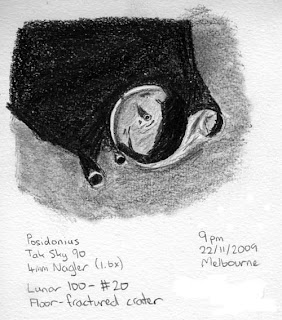Last night we were utterly tuckered out. We convinced ourselves there were some clouds around.
For tonight, our last with the clearer skies of the Rat, we prepared well by napping in the afternoon and not having too strenuous a day. Very important, this sort of preparation. Happily, it wasn't as cold as the last few nights; sadly, for us, the moon is enormous (86% full, according to my adorable widget) and was hanging bulbous and annoying right near the Pleiades.
Anyway, we started by looking at Jupiter - very low in the sky, in fact just about disappearing behind the roof of the house. It wasn't an awesome view, but most importantly for me I'd realised that Neptune is very close to it at the moment. We're pretty sure we found it; the blob of light certainly looked like a disk, rather than a point of light, just as Jupiter's moons (let alone Jupiter) and Mars resolve. There was no blue/green colour, because it was too low to the horizon; it was yellow/red instead. For the same reason, Jupiter was an awesome fake yellow/orange colour, although it was impossible to resolve it properly thanks to the atmospheric issues. ETA: apparently Neptune is currently mag 8, so I'm pretty pleased at finding it, it being so close to the moon and all.
Next, we tried checking out some stuff near Canis Major. First up, M41, an open cluster. I'll admit here and now that I am not usually wowed by open clusters (in my vast experience of them). This one was pretty enough... but it just looks like a particularly dense clump of stars. Which it is. Nearby, we looked at Cr121 - where Cr, according to my trusty Pocket Sky Atlas, stands for Collinder, presumably the dude who catalogued it.
Swinging around we amused ourselves looking for 47Tuc, and although the sky was still washed out it was still all tendril-y looking. Swinging back, J got a bit ambitious and tried looking for M44 - the Beehive. We didn't find it - too low, and therefore behind the trees from our position. We did find some cluster, but we have no idea whether it has an official designation.
The Orion nebula, as always, looked good - although it too was a bit washed out from the moon. Despite that I think I'm picking up new details every time; I don't remember noticing a star below the Trapezium before. And M43 looked quite obvious too. J picked up the Small Magellanic Cloud in the binocs, as well as various other bits and pieces. I had a quick look - I'm not very good with binocs, at least partly thanks to the specs - but in my wavering grip even I could see M42, vaguely, as well as a couple of the open clusters.
Finally, we wreaked vengeance by looking at the moon - remembering this time to put the neutral density filter on, although to be honest I still felt blinded. Tycho and Copernicus were both in full view, with their respective ejecta very obvious; it was a brilliant sight.
Overall, we've had good viewing up here. It's going to be weird to go home to very obvious light pollution.

















